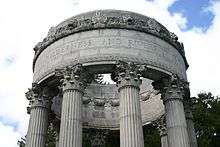Pulgas Water Temple
The Pulgas Water Temple is a stone structure west of I-280 at 86 Cañada Road, Woodside, California, United States, designed by architect William G. Merchant. It was erected by the San Francisco Water Department to commemorate the 1934 completion of the Hetch Hetchy Aqueduct and is located at the aqueduct's terminus. In 1938, the original water temple was replaced with the current design.[1]

The water temple consists of fluted columns arranged in a circle, upon which a large stone masonry ring with the words "I give waters in the wilderness and rivers in the desert, to give drink to my people " [from Isaiah 43:20] are inscribed. There is a large, tree-lined reflecting pool to the east. The water temple grounds can be rented for weddings or special events.
San Francisco and surrounding communities get water from the Hetch Hetchy Reservoir approximately 160 miles away via the Hetch Hetchy Aqueduct. Water once made the journey to the Pulgas Water Temple and flowed over a small C-shaped waterfall within the water temple itself where it continued approximately 800 feet down a canal to the west into Upper Crystal Springs Reservoir. Starting in 2004, water no longer flows through the temple, but instead is diverted to a nearby treatment plant where chloramine added at the Sunol treatment plant is removed. The retreated water then either enters the drinking water system after being chloraminated yet again at another plant or is stored as surplus in Upper Crystal Springs Reservoir.
Early History
California State Historical Landmark #92[2] is located here, commemorating the camping place, somewhere in this immediate area, by the Spanish Portola expedition on November 11, 1769. Members of the expedition were the first Europeans to explore inland areas of California, and the first to see San Francisco Bay. On the previous day, while camped at San Francisquito Creek, expedition leaders made the decision to turn around and begin the return journey to San Diego. This meant first retracing their steps north to where they had crossed Sweeney Ridge from the coast.[3]
"Pulgas" is the Spanish (and Portuguese) word for "fleas", which were encountered by early Spanish explorers of the area. In this location, the name comes from the former Rancho de las Pulgas, an early Spanish land grant.

See also

References
- ↑ San Francisco Water Department. "Aqueduct Spans Northern California" (PDF). p. 5. Archived from the original (PDF) on 2010-06-02. Retrieved 2016-06-08.
- ↑ CHL 92
- ↑ Bolton, Herbert E. (1927). Fray Juan Crespi: Missionary Explorer on the Pacific Coast, 1769-1774. HathiTrust Digital Library. p. 237. Retrieved April 2014. Check date values in:
|access-date=(help)
External links
![]() Media related to Pulgas Water Temple at Wikimedia Commons
Media related to Pulgas Water Temple at Wikimedia Commons
- Photograph from Barak Yedidia Photography
- Photograph from Stuart Liroff's Flickr Site
- Google Maps aerial photo
- San Francisco Chronicle article on the diversion of water from the temple
- SF PUC
Coordinates: 37°29′00″N 122°19′02″W / 37.483322°N 122.317146°W